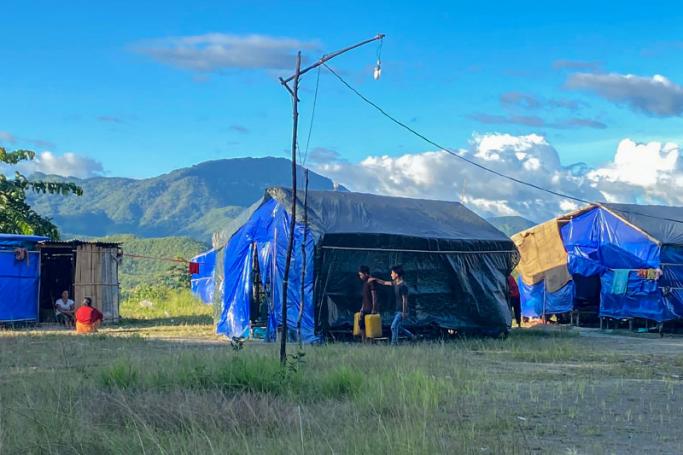Since the coup in February 2021, the country that has taken the most refugees from Myanmar is India. Most of those refugees are in the western Indian states of Mizoram and Manipur, with the majority having come from Chin State.
According to United Nations Refugee Agency (UNHCR) figures, since the coup until 1 June 2022, there were 691,200 Internally displaced people who were forced to flee from their homes to other areas within the country.
During the same period, there were 40,000 refugees, people who fled from their homes and are now sheltering in a different country. The vast majority of these, 39,800, are in India with the remaining 200 in Thailand.
Many people have been forced to flee their homes in Chin State by junta offensives and atrocities such as the burning of Thantlang Town that caused all of the town's 10,000 residents to flee.
Officially India, which has not signed the 1951 United Nations Refugee Convention nor its 1967 Protocol, has not welcomed Myanmar refugees.
On 18 March 2021, when it was estimated that there were fewer than 1,000 Chin refugees in Mizoram, India’s Ministry of Home Affairs instructed the states of Arunachal Pradesh, Manipur, Mizoram, and Nagaland to take “appropriate measures” to stop the inflow of Burmese refugees from neighbouring Chin State.
Last year the Indian central government also instructed the governments of the North-East states and the Assam Rifles not to provide shelter to any of the displaced people and to deport them. But, the Mizoram Chief Minister Zoramthanga refused to obey the order and said it was the duty of the Mizo people to care for the refugees.
Despite this, the Mizo people from the Indian State of Mizoram have been far more supportive towards Chin refugees.
They regard the Chin as their brethren. They speak dialects of the same language and there is a history of intermarriage and family kinship on both sides of the border. Also, many have not forgotten the years of the Mizo struggle during the 1960s and 1970s when it was the Chin across the border that provided the Mizo with refuge from the bombing of the Indian Air Force and reprisals of the Indian security forces.
The Mizo have been far more sympathetic, but because of poor infrastructure, a lack of resources and a lack of help from the central government, they have been stretched to beyond capacity by the arrival of the refugees from Myanmar.
According to Indian Government sources, aid NGOs, church groups and village officials have formed “refugee caretaker committees” and are looking after the displaced people, with help from the local administration. The NGOs are also mobilising donations of funds and relief such as clothes and food for the refugees.
The few reports filtering out of Mizoram reveal that Chin refugees are living in rural makeshift refugee camps where up to 100 people sleep in one room. They do not have adequate shelter, food, water and other survival necessities, including basic healthcare, even as Covid cases are popping up across Mizoram.
The entire task of hosting refugees is being handled by village communities organised by powerful institutions like the Young Mizo Association and the Mizo Baptist Church that have also been organising fundraisers and distributing relief supplies. Schools have enrolled Chin children.
Though they feel welcome and secure in Mizoram, the Chin long to go back to Myanmar, but there is little hope of return. Many are reported to be suffering from Post-Traumatic Stress Disorder (PTSD) because of the way they have suffered.
The Mizoram Government has initiated a process of issuing ID cards to the refugees from Myanmar in Mizoram.
“These are temporary identity cards that include their name, age, place of origin and their current residence. We have issued the cards for the safety of the refugees as well as easier identification,” said Lalchamliana, the Mizoram Home Minister, to news website Indianexpress.com.
Indian Prime Minister Narendra Modi’s government has implemented various measures to minimize or obscure the growing humanitarian crisis along the border with Myanmar’s Chin State.
The Manipur Governor, La Ganesan referred to refugees as infiltrators when he spoke to villagers at Kamjong district headquarters in Manipur on 20 April 2022. He said that infiltrators were deliberately trying to sneak into India, mostly in the border areas, from Myanmar and that the process should be checked and the infiltrators sent back.
International humanitarian organizations have been effectively barred from providing help to the Chin refugees in India. They have also been barred by the junta authorities in Myanmar from helping internally displaced persons (IDPs) in Chin State, meaning that most displaced Chin people have no access to international aid.
India’s Ministry of External Affairs has also stalled the issuance of exit visas to Chin refugees who otherwise would have the necessary documents to emigrate to the United States or other countries.
Representatives of the Chin-American community have said that the more than 40,000 refugees and IDPs are in desperate need of necessities such as shelter, clothing, food, and water, as well as COVID-19 vaccinations, but Modi’s government is allegedly blocking such aid.
The future does not look good for the refugees from Chin State in India. There has been little help from the Indian Government and they are suffering in bad living conditions. Aid organizations suggest the Indian authorities need to be more compassionate and offer the refugees more support.












